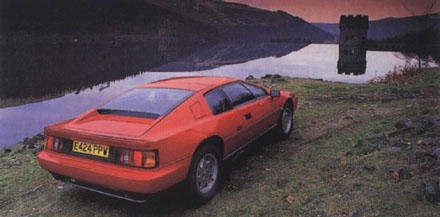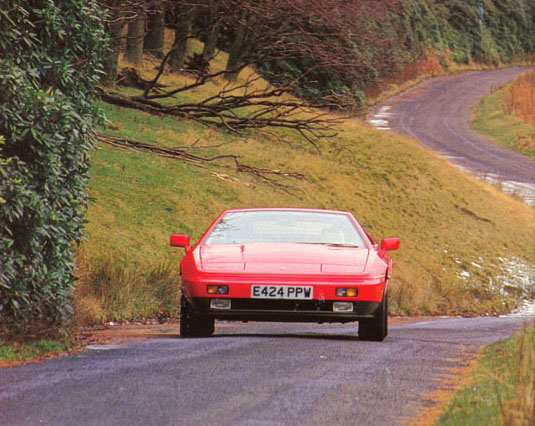
Running on Empty
Autocar Magazine road tests the Lotus Esprit Turbo - January 1988
"Heading north and west from Hethel, driving in the spirit of the car on a mixture of roads, how far will the new Lotus Esprit Turbo travel on a full tank of petrol?" For the thousands who have entered our win-a-Lotus competition, the answer to this tie-breaker question looms large. Mark Hughes sets off to discover it and on the way discovers, again, what a fine car the Esprit has turned into. Photography by Stan Papior.
How much further can this thing go?" I muttered to no-one in particular. There we were - a scarlet Lotus Esprit Turbo, Lotus Development Engineer David Hudson and Myself driving on and on into the night, waiting for a splutter from the engine as it drank the last drops from its 17.3 gallon fuel tank. The low fuel warning light had been on continuously for the past 30 miles. Surely it couldn't be long?
I was an odd mission. Though-out the day, since leaving Hethel at dawn, we'd been trying to establish one crucial fact; how far would the new Lotus Esprit Turbo go before the full tanks ran dry? Regular Autocar Readers will know the reason for this. The thousands who entered our competition to win the first right hand drive Esprit Turbo off the production line had to guess to one decimal point the mileage the car would cover "heading north and west from Hethel, driving in the spirit of the of the car on a mixture of roads."
We felt a weighty burden as we traversed England. Miss an overtaking chance and Arthur Blogs might win instead of John Smith. The destiny of the prize car was in our hands. We understood "driving in the spirit of the car," to means driving hell for leather pretty much all the time, so that's what we did. Apart from producing the answer form the competition tie-breaker, the exercise gave a marvellous opportunity for a prolonged evaluation of this Lotus.
We tried hard to find a mixture of roads, from winding hill passes to motorways, from Norfolk lanes to urban back streets. We spent some time in Peterborough as we neared the end of our journey, not because we were charmed by the place but for two very good reasons. Firstly, we felt that our route had not included enough town driving to be truly authentic, and secondly, wanted to run out of petrol somewhere sensible. To have run dry at high speed would have risked burning a piston, and to conk our just after a blind bend on a trunk road would have been downright stupid. Best to let it happen under street lights, where we could be seen.
On and one the Esprit Turbo went, sucking fuel up from its boot despite our assault on the throttle. We got bored in Peterborough before it wanted to give up, and headed Hethel-wards along the A47. Somewhere between Wisbech and King's Lynn, the Esprit Turbo finally waved the white flag. Our day had begun at 7:30am at the Lotus petrol pump, brimming each of the two fuel tanks and zeroing the trip. Lotus had spent the previous day with Correvit light beam, equipment - the same as Autocar's road test team uses - measuring odometer accuracy. Standing looking at the car's line made me think that, while the old Esprit Turbo had not looked particularly dated, Lotus Design's Peter Stevens' subtle softening of the lines has pitched Giugiaro's original shape back into the classic generation. It's as if a huge pair of hands have smothered the old car, like a potter works his clay, and knocked off all those sharp lines.
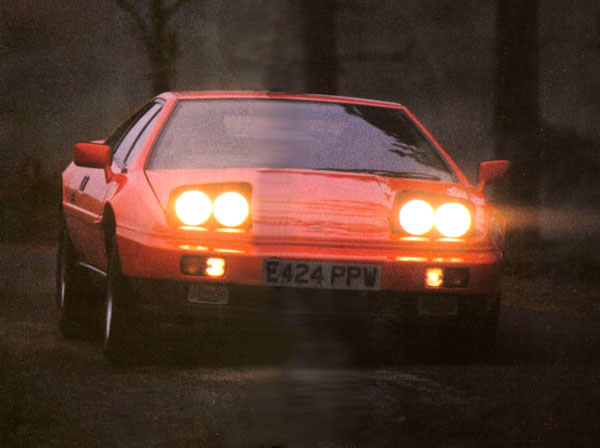
Lotus says dimensions have changed little, yet the car now looks all of a piece, with neat attention to detail. The roof-line, viewed from the side, forms a smooth double curve instead of a series of straight edges and angles. From head-on the slight crown of the bonnet and curve of the windscreen - both were flat on the old shape - show a distinct family resemblance to the Excel. The old car's stick out air intakes behind the rear three-quarter windows have been discarded for a flush finish, allowed by the way these windows now tuck inwards. The sills, bumpers and front air dam are neatly blended into the body shape. The fuel fillers are concealed behind the smooth flaps. A space between the rear buttresses is covered by an external glass panel (although the naturally aspirated Esprit still has a "tunnel back"). The car definitely looks a cut above its predecessor, and more of a match for Porsche and Ferrari.
The Lotus had been tidied up inside too. The old Esprit always looked inviting, with its sumptuous padding and creased leather, and at first sight little has changed. Settling into the driver's seat soon conveys the differences. The instrument binnacle has been tidied, although it still sits proud of the flat facia. The white-on-black VDO dials are small but far more readable, especially in bright light. Those at the extremities, tucked away in little tunnels and partially obscured by the steering wheel, cover battery on the left and fuel tank on the right. In the centre are a tachometer, calibrated to 7000rpm and a 160phm speedometer, with smaller gauges for oil pressure, turbo boost and water temperature. The clumsy sliding switchgear at either edge of the binnacle has been replaced by square push-push Maestro switches, which are far more pleasant to use. The two-spoke steering wheel has given way to a three-spoke wheel with a thick, leather covered rim, neatly shaped where the hands naturally fall. Greater attention has been paid to the driving position: the seat is wider and far more supportive under the thighs, headroom has increased and there is more room around the pedals. The Esprit Turbo doesn't lack executive equipment, with central locking, electric windows and door mirrors and a tilt / removable sunroof as standard. Air conditioning is £1050 extra. Lotus must be sick of hearing it, but those Austin Maxi interior door handles live to fight another day, striking a touch of incongruity for those who remember BL's worthy five-door holdall. Type approval cost is the sole reason for keeping them - replacement would mean another bout of expensive crash testing and validation. Even in the GM era, Lotus doesn't have that sort of money.
With the tanks full, we reckoned we had between 320 and 340 miles to fit into the day. The forecast promised something better than East Anglia’s rain and the Pennines. Those early miles on the traffic-laden A47 and A17, past Swaffham, King's Lynn, Sleaford, Newark and Mansfield, didn't tell much about the Esprit Turbo's handling, but there was plenty to learn about other areas of the car's dynamics.
The 2.2 litre four-cylinder all alloy engine, with twin upstairs camshafts and 16 valves, maybe a little long in the tooth, but you'd never know it. The carefully engineered Garrett AiResearch T3 blower instillation - identical to the old Esprit Turbo apart from a water-cooled turbocharger and integral wastegate, which increases power by 5bhp to 215bhp at 6500rpm - makes this a most tractable turbo.
You sense a trace of lag when you floor the trottle, and the power starts to build dramatically from a shade under 3000rpm. There's no crude kick-in-the-back delivery, just an even and strong swelling of force which carries you relentlessly to 7000rpm (where a fuel shut-off rev limiter comes into play if you don't watch the tacho). The car doesn't feel quite as quick when you point it in a straight line as Lotus's 0-60 in 5.3 secs and 0-100 in 14-7 secs figures suggest, but that's because power delivery is so well-honed and smooth through this broad rev band. This is the best possible characteristic for rapid overtaking. Slip the nose out from behind a slower car for a peep at the road ahead, slot down to fourth or third, squeeze the accelerator and you’re whirled forwards as the four-cylinder buzz builds up behind you, spinning willingly up to 7000rpm. Soon you're picking off three of four cars instead of just one. You can forget about driving to suit the turbo 0 you know, waggling your right foot to keep the revs on the edge of the boost - because you really wouldn't know it was there, until you lift off and hear the muttering of the waste gate, like a horse breathing into you right ear.
Mechanically, the new car's major change is the adoption of the Renault GTA's transaxle in place of a Citroen unit. While the ratios are marginally taller, the alteration manifests itself more strongly in gear change feel (and, incidentally, more luggage space). The stubby lever, topped by an uncomfortable Renault knob, has a reasonably light and short throw, but it could be crisper. Cable (instead of rod) operation to the gearbox mounted aft of the engine is an awkward linkage to engineer, but Lotus hasn't matched the precision of the GTA's gear change. The lever would be easier to use if it was mounted an inch or two further forwards to remove the slightly "crooked arm" feel when selecting second.
The other thing I learned early is how much more substantial this new Esprit Turbo feels. The former car felt distinctly "assembled" as it crashed and flexed over harsh road surfaces. The new car turns lumps and ruts into dimples. You feel every irregularity as you might expect of a sensitively suspended sports car, but there is a much greater feeling of solidity, with none of the shaking and quivering of the old car. Significantly better torsional rigidity partly explains this, for the new composite body, incorporating Kevlar, is stiffer and more securely attached to the galvanised steel backbone chassis. Bodies are now made by Lotus's vacuum-assisted resin injection (VARI) process, instead of the old "brush and bucket" method. Coupled with this are improved damping which rounds off road bumps beautifully, giving even bumps and rebound characteristics. The ride is terrific for a sports car.
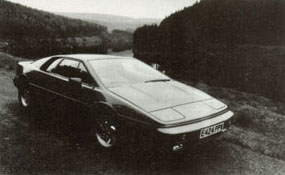
One we were beyond Chesterfield and climbing into the Peak District, there were fewer cars on these sinuous roads. The Lotus was now in its element, revealing its handling composure to the full. This car is virtually unrivalled for its poise through every kind of corner, from a hairpin to a flat-out kink, and at anything up to nine-tenths effort its balance is completely neutral. The Snake Pass to Glossop to the right sort of road. The sweeping of the tarmac, first one way and then the other, setting up a natural rhythm as you confidence grows. The front wheels respond to sensitive steering inputs deliciously, feeding every little change in the surface to your hands. Turn into a corner and the nose dives eagerly for the apex, crisply and precisely. Back on the accelerator - in third or fourth for this 70-90 stretch - and the Esprit Turbo surges round, with barely any roll, totally committed to its line. Push it harder still and the back wheels begin to slide just a touch, but it's graceful, controllable, and happens only near the amazing peak of cornering power. All the time you wonder how much faster you could have taken the corner you've just sailed through. So stable is this car and so astounding is the grip from its Goodyear NCT tyres. The old Esprit was fast on a twisting road with prodigious amounts of road holding, but never quite as reassuring as the new model. One sometimes experienced a slightly unsettled feeling when the old car was corning hard as the chassis flexed by a small amount. But the new Esprit's extra torsional stiffness - thanks to the body shell taking a greater share of the loading - seems to have cured the problem. On top of this, superior damping keeps the wheels more securely on the road. This higher degree cornering stability is the most notable advance of the new Esprit Turbo.
Braking is up to the ability of the rest of the car, although the pedal effort required somehow seems at odds with the delicacy of the other controls. There's an ample tug from the four disks (those at the rear are now inboard) which inspires confidence, and locking the front wheels takes some doing. Enjoying these roads meant that darkness was now drawing in, and we still had half a tank left. Seeking further variety of driving, we selected a fast rout south on the M1 and A1. Where the road was empty we could sustain higher speeds, and another improvement made itself felt, noise suppression is vastly improved, primarily because of better engine and body insulation, and smoother aerodynamics. By this stage the engine note, tyre roar and wind noise of the old Esprit Turbo would have become tiresome, yet se still felt fresh.
The trip was reading 335 miles when the fuel light started to blink. As we neared Peterborough it was on all the time. We were still trying hard, using 7000rpm in first and second between traffic lights and roundabouts, and then dawdling for a while to remind ourselves of how very tractable the Esprit Turbo is around town. If you wish, the engine will pull smoothly from little more than 1000rpm, and steering effort is quite acceptable for manoeuvring. Only poor visibility through the window slot behind you makes the car at all tricky in crowded environments.
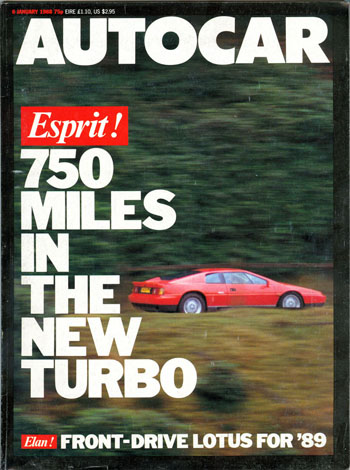
It was closed to midnight when the Esprit Turbo finally coughed just short of King's Lynn. It spluttered for a quarter of a mile and then coasted to a halt. It came to life again with another turn of the key, and then went only 100 yards further before dying for good. The distance covered is something you'll have to wait to discover until the 27 January issue of Autocar, when we announce the winner of our competition.
What did emerge from the day is that the new Esprit Turbo's economy is very impressive indeed. On top of all the other things the car does so well, this comes as a bonus.
What started out as a reshaping exercise by Lotus grew, during the 15 month development period, into a thorough ironing-out of the old Esprit Turbo's weaknesses. The price has gone up by £3000 to £29,600, but for that money you get a far more balanced and refined car, one which pulls Lotus unquestionably into the Porsche 911 and Ferrari 328 GTB territory - as one of our Readers will soon find out.
Thanks to Alan Paterson for this article. E424 PPW is still running well and Alan is the present Owner.
